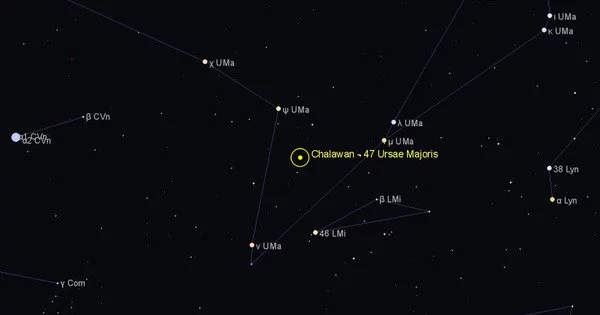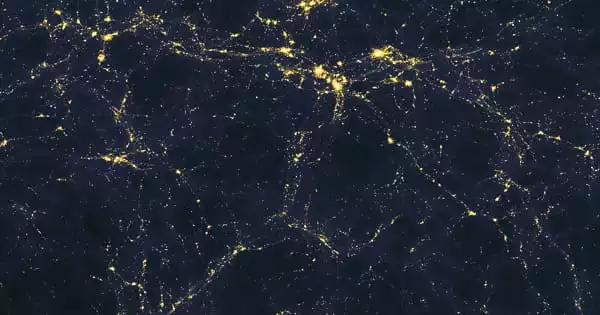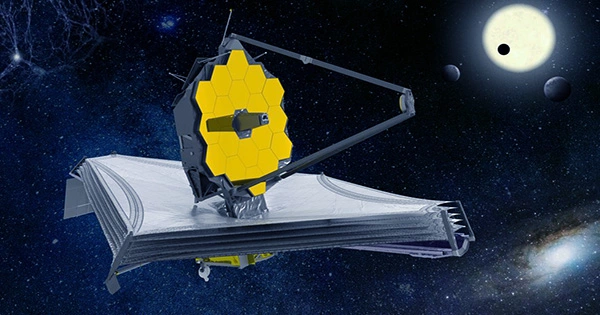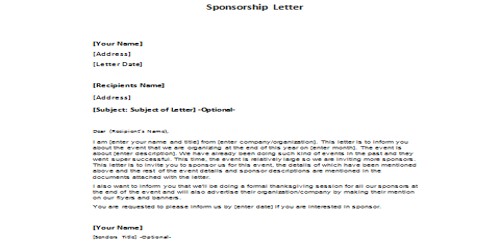47 Ursae Majoris is a yellow dwarf star located in the constellation Ursa Major, approximately 46 light-years from Earth. It is 45.9 light-years away from Earth. It is located in the south-central part of the Great Bear Constellation Ursa Major. Its mass is comparable to that of our Sun. It is slightly more metal-rich than the Sun, with around 110 percent of the Sun’s iron abundance. It is also slightly hotter than the Sun, with a spectral type of G1V, at around 5,855 K. 47 Ursae Majoris has an absolute magnitude of +4.29, implying that it has a visual luminosity that is roughly 60% that of the Sun.
47 Ursae Majoris, like the Sun, is on the main sequence, converting hydrogen to helium in its core via nuclear fusion. The star may be around 6,000 million years old based on its chromospheric activity, though evolutionary models suggest an older age of around 8,700 million years. It is located southeast of Omega UMa, southwest of Psi UMa, northeast of 46 UMa, and northwest of 55 UMa. As of 2011, three extrasolar planets are thought to orbit the star (designated 47 Ursae Majoris b, c, and d; the first two later named Taphao Thong and Taphao Kaew).

The star is relatively close to the Solar System, with a parallax of 71.11 milliarcseconds, corresponding to a distance of 45.913 light-years, as measured by the Hipparcos astrometry satellite. It is visible to the naked eye with an apparent magnitude of +5.03 and an absolute magnitude of +4.29, implying a visual luminosity approximately 60% greater than the Sun. With a spectral type of G1V, it has a similar mass to the Sun but is slightly hotter at around 5,882 K. and slightly more metal-rich, with approximately 110 percent of the solar abundance of iron.
47 Ursae Majoris, like the Sun, is on the main sequence, converting hydrogen to helium in its core via nuclear fusion. The star may be around six billion years old based on its chromospheric activity, though evolutionary models suggest an older age of around 8.7 billion years. Other studies have estimated the star’s age to be between 4.4 and 7 billion years. Because of its low magnetic activity, it is a Maunder Minimum candidate star.
Planetary system
Geoffrey Marcy and R. Paul Butler announced in 1996 the discovery of an exoplanet (47 UMa b) in orbit around 47 Ursae Majoris. The discovery was made by observing the Doppler shift of the star’s spectrum, which corresponded to changes in the star’s radial velocity caused by the planet’s gravity. The planet was discovered as the first long-period extrasolar planet. It has a low-eccentricity orbit, unlike the majority of known such planets. The planet is at least 2.53 times the mass of Jupiter and orbits its star in 1,078 days, or 2.95 years. It would be located in the Solar System between the orbits of Mars and Jupiter.
The Hipparcos probe’s preliminary astrometric measurements in 2001 suggested that the orbit of 47 UMa b is inclined at an angle of 63.1° to the plane of the sky, implying that the planet’s true mass is around 2.9 times that of Jupiter. However, subsequent analysis revealed that the Hipparcos measurements were insufficient for accurately determining the orbits of substellar companions, and the inclination and true mass remain unknown.
















